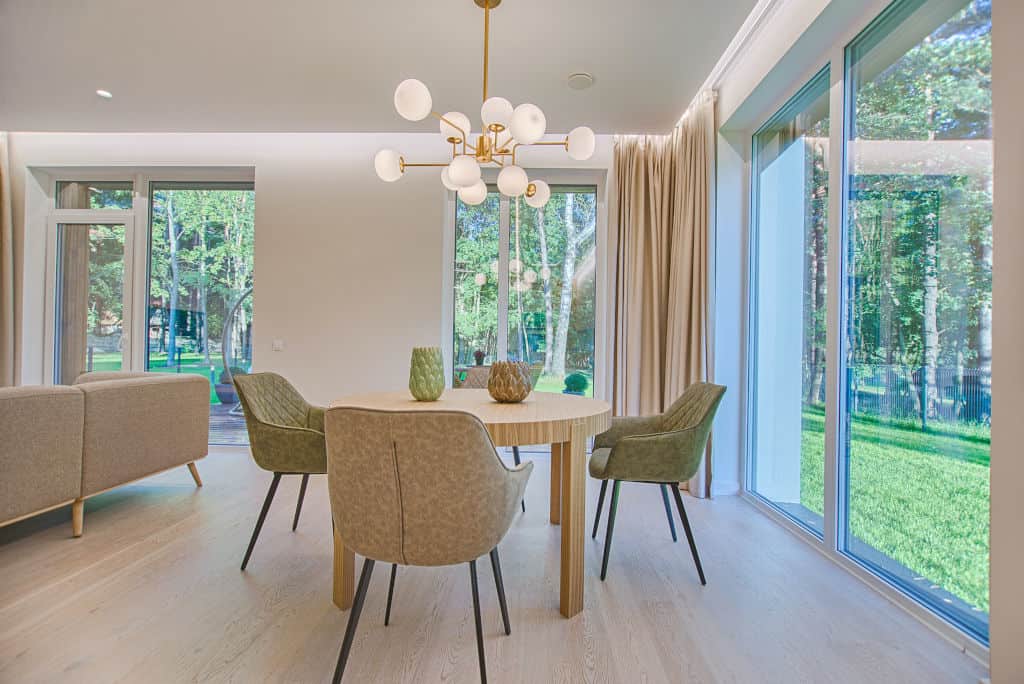When it comes to home construction or renovation, perhaps no exterior decision has more impact on your home’s appearance, functionality, or energy efficiency than the design and type of windows. Despite their importance, it may be one of the most underrated aspects of home design, but a good architect knows that the right window can enhance the beauty of a home in immeasurable ways.
When planning your home renovation (or new construction), the 5 aspects of window design are important to consider:
Let’s discuss each individually.
window material or composition
You have several options when it comes to the material used to construct a window frame.
Wood windows are considered the classic-looking or more traditional option. The advantages to wood windows are the natural finishes they feature which can really enhance certain types of homes.
Most wooden windows are stained, conditioned, or treated, and some are encased in aluminum to offer protection from damage. However, due to their natural state, wood windows will require more maintenance than some of the other materials to keep them clean, safe from the elements, and looking like new.
Vinyl windows are the most common windows used in homes today. Their popularity is likely related to their price point and the fact that they’re designed for durability against all types of weather. Unlike a wooden window, you never have to worry about a vinyl window getting warped by water or by heat.
Fiberglass window frames are considered the strongest and require the least amount of maintenance from a homeowner. Additionally, by virtue of their composition, fiberglass windows offer vibrant colors resistant to fading. They’re the more expensive option than the previous two materials, but for many homeowners, their durability and resistance to leaking or weather damage are worth the cost.
window types
There are several types of windows to consider, and a homeowner’s decisions are often related to how actively an occupant opens and closes the windows of a home. The size of the window must also be considered when thinking about a particular style.
What follows is not an exhaustive list of window types, but these are some of the most popular.
Casement or “crank” windows can be opened by turning or spinning the reel of the crank. These windows open by using hinges, similar to what you see on a door. By using this design, the window provides an unobstructed view. Crank windows are quite useful in hard-to-reach places like over the kitchen sink or across a countertop.
Awning windows also open by turning a crank, but these windows open the way old-timey garage doors were once designed—they have hinges at the top and swing outward from the bottom. Like casement windows, awning windows are ideal for places difficult to reach such as over the whirlpool tub in your master bathroom.
Double-hung windows are the most commonly used option. They are constructed as two separate panels of glass which are locked in the middle and can be opened by sliding the bottom panel upward or the top panel downward.
Picture windows are appropriately named. They are often larger windows situated within a “picture frame.” Usually, these windows are designed to provide a wide or vast view to the outside and not intended to be opened.
Bay or “bow” windows are multiple windows spaced closely together. Bay windows feature three panes where the centerpiece juts out from the side windows which are set at angles. Bow windows provide the same look, but they’re comprised of more than three panes, which takes up more space. These types of windows add dimension to a home’s exterior appearance, allow for more space in the room they occupy, and they can be casement, double-hung, or picture windows.
window shape
Granted, the most common shape of a window is square, but renovators looking to experiment with other geometric shapes have several options.
As referenced in the explanation of bay windows, irregular polygon shapes can protrude away from the home providing unique dimension to the home’s exterior as well as additional interior space.
Circular and hexagonal windows are reminiscent of what you typically see on a cruise ship rather than a home. However, for homeowners looking to break up the monotony, these windows are a nice option. They tend to be small and often sit at the apex of a room with ceiling peaks (A-frame). They’re also typically used in spaces where the interior space benefits from less sunlight or outside exposure.
Arched and apex windows often accompany other square or rectangular windows underneath them. These shapes are commonly used to align with a distinct house frame that features—you guessed it: arched or A-framed entrances or patterns.
window size
Depending on how much natural light or privacy a homeowner desires throughout the various rooms in their home, and dependent upon the size of the rooms or walls of the home, there are countless options when it comes to determining window dimensions.
What some homeowners may not know, however, is that windows have both a head height and a sill height which are regulated by building codes. For example, there are restrictions of sill height in rooms where people sleep.
Because of the many size and shape options, it’s best to plan a renovation carefully because you don’t want to run into any surprises related to building codes that can influence where a window can be placed in relation to where walls, ceilings, or floors connect to each other.
room purpose
As we’ve pointed out, there’s much to consider when planning the windows for your home, but the biggest hurdle in designing the renovation can be perspective. Homeowners can get so focused on improving the exterior of the home that they overlook how the interior spaces are impacted by their decisions.
Depending on the direction a wall faces, your local climate, and the use of the room, an interior space can suffer from too much sunlight. For example, it’s common to want a lot of natural light in a kitchen, but dining rooms, bathrooms, and living rooms might not benefit from many (or large) windows.
For example, bathrooms require some privacy, living rooms often contain entertainment centers and TV screens which reflect light, and today’s dining rooms are often intended to imitate fine dining where attractive, modern, or ornate lighting creates a dimming ambiance.
Meanwhile, there are other spaces in the home where we desire as much natural light as possible—most commonly the kitchen or a sitting room with a beautiful view of a back yard or the pool.
As is the case in any industry that features artistic flourish and design, selecting windows for your home can feel overwhelming. However, if you carefully and thoughtfully consider the options we’ve shared (and allow for the inevitable supply chain delays) you can avoid the stress and mistakes that spoil renovation or building projects that are supposed to be fun and exciting.
Laura Davis is a registered architect and interior designer in the state of Texas and Colorado, and a founding member of hpd architecture + interiors. Laura's extensive experience includes residential as well as commercial and retail projects. She also has a particular interest in restoration, holding a certificate in Historic Preservation. She is energized by the character of older homes and the stories of those who have lived there. Responding to the needs of the current owner, while also honoring the personality of the original home is a delicate process to be enjoyed.


0 Comments